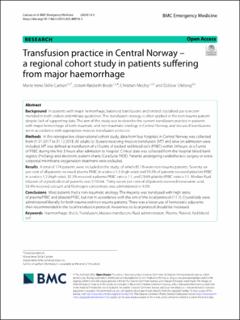| dc.contributor.author | Carlsen, Marte Irene Skille | |
| dc.contributor.author | Brede, Jostein Rødseth | |
| dc.contributor.author | Medby, Christian | |
| dc.contributor.author | Uleberg, Oddvar | |
| dc.date.accessioned | 2024-01-17T09:40:27Z | |
| dc.date.available | 2024-01-17T09:40:27Z | |
| dc.date.created | 2024-01-14T14:23:31Z | |
| dc.date.issued | 2024 | |
| dc.identifier.issn | 1471-227X | |
| dc.identifier.uri | https://hdl.handle.net/11250/3112065 | |
| dc.description.abstract | Background: In patients with major hemorrhage, balanced transfusions and limited crystalloid use is recommended in both civilian and military guidelines. This transfusion strategy is often applied in the non-trauma patient despite lack of supporting data. The aim of this study was to describe the current transfusion practice in patients with major hemorrhage of both traumatic and non-traumatic etiology in Central Norway, and discuss if transfusions are in accordance with appropriate massive transfusion protocols. Methods: In this retrospective observational cohort study, data from four hospitals in Central Norway was collected from 01.01.2017 to 31.12.2018. All adults (≥18 years) receiving massive transfusion (MT) and alive on admission were included. MT was defined as transfusion of ≥10 units of packed red blood cells (PRBC) within 24 hours, or ≥ 5 units of PRBC during the first 3 hours after admission to hospital. Clinical data was collected from the hospital blood bank registry (ProSang) and electronic patient charts (CareSuite PICIS). Patients undergoing cardiothoracic surgery or extracorporeal membrane oxygenation treatment were excluded. Results: A total of 174 patients were included in the study, of which 85.1% were non-trauma patients. Seventy-six per cent of all patients received plasma:PRBC in a ratio ≥ 1:2 (high ratio) and 59.2% of patients received platelets:PRBC in a ratio ≥ 1:2 (high ratio). 32.2% received a plasma:PRBC-ratio ≥ 1:1, and 23.6% platelet:PRBC-ratio ≥ 1:1. Median fluid infusion of crystalloids in all patients was 5750 mL. Thirty-seven per cent of all patients received tranexamic acid, 53.4% received calcium and fibrinogen concentrate was administered in 9.2%. Conclusions: Most patients had a non-traumatic etiology. The majority was transfused with high ratios of plasma:PRBC and platelet:PRBC, but not in accordance with the aim of the local protocol (1:1:1). Crystalloids were administered liberally for both trauma and non-trauma patients. There was a lower use of hemostatic adjuvants than recommended in the local transfusion protocol. Awareness to local protocol should be increased. | en_US |
| dc.description.abstract | Transfusion practice in Central Norway - a regional cohort study in patients suffering from major haemorrhage. | en_US |
| dc.language.iso | eng | en_US |
| dc.publisher | BioMed Central (BMC) | en_US |
| dc.relation.uri | https://bmcemergmed.biomedcentral.com/articles/10.1186/s12873-023-00918-3 | |
| dc.rights | Navngivelse 4.0 Internasjonal | * |
| dc.rights.uri | http://creativecommons.org/licenses/by/4.0/deed.no | * |
| dc.title | Transfusion practice in Central Norway - a regional cohort study in patients suffering from major haemorrhage | en_US |
| dc.title.alternative | Transfusion practice in Central Norway - a regional cohort study in patients suffering from major haemorrhage. | en_US |
| dc.type | Peer reviewed | en_US |
| dc.type | Journal article | en_US |
| dc.description.version | publishedVersion | en_US |
| dc.source.volume | 24 | en_US |
| dc.source.journal | BMC Emergency Medicine | en_US |
| dc.source.issue | 1 | en_US |
| dc.identifier.doi | 10.1186/s12873-023-00918-3. | |
| dc.identifier.cristin | 2226019 | |
| cristin.ispublished | true | |
| cristin.fulltext | original | |
| cristin.qualitycode | 1 | |

